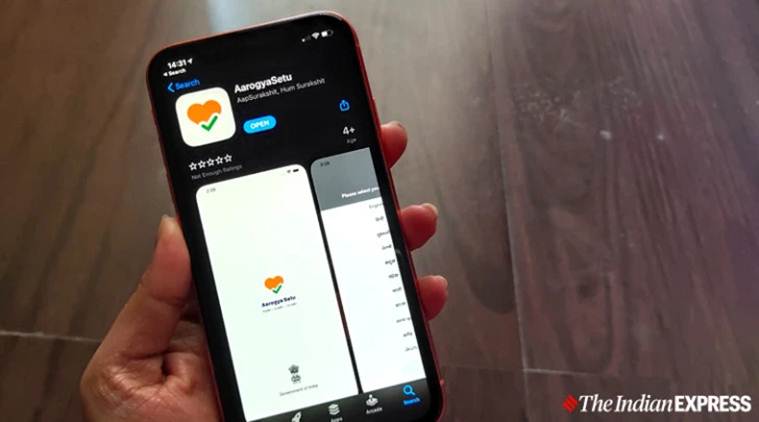 Aarogya Setu is a contact-tracing app developed by the National Informatics Centre (NIC) under the Ministry of Electronics and Information Technology. (Express photo: Sneha Saha)
Aarogya Setu is a contact-tracing app developed by the National Informatics Centre (NIC) under the Ministry of Electronics and Information Technology. (Express photo: Sneha Saha)
In a significant dilution from previous Home Ministry directions, the latest MHA order on Sunday regarding Aarogya Setu downloads shifted towards much more flexibility.
The May 17 MHA order states: “With a view to ensuring safety in offices and workplaces, employers on best effort basis should ensure that Aarogya Setu is installed by all employees having compatible mobile phones. District authorities may advise individuals to install the Aarogya Setu application on compatible mobile phones and regularly update their health status on the app.”
The “best effort” addition is a significant rollback from the MHA order on May 1 that ushered in the third lockdown phase: “The local authority shall ensure 100% coverage of Aarogay Setu app among the residents of Containment Zones.” It had continued: “Use of Aarogya Setu app shall be made mandatory for all employees, both private and public. It shall be the responsibility of the Head of the respective Organizations to ensure 100% coverage of this app among employees.”
While the MHA’s dilution may make a refusal or inability to download the government’s COVID-19 contact tracing application less of a legal liability, states still have the power to make the application mandatory.
The application is already mandatory for central government employees and for travelers crossing several borders nationwide. Also, it has been made mandatory for select groups by the Airports Authority of India, by the Indian Railways, by sporting authorities, by state government directions such as in Uttar Pradesh, and by private companies such as Urban Clap and Zomato.
In one example, the Noida Police had said that not having the application would be publishable with imprisonment up to six months or fine up to Rs 1,000.
The Kerala High Court is hearing a petition against the central government’s order making downloading of the app compulsory for people returning to their workplaces after the lockdown.
Former Supreme Court Judge Justice B N Srikrishna told The Indian Express on May 13 that the May 1 MHA order language regarding mandatory Aarogya Setu downloads was “utterly illegal.”
“Under what law do you mandate it on anyone? So far it is not backed by any law,” he had said. “It is highly objectionable that such an order is issued at an executive level. Such an order has to be backed by Parliamentary legislation, which will authorise the government to issue such an order.”
After the announcement of the May 1 order, IT Ministry officials and industry developers of the Aarogya Setu app told The Indian Express that the Home Ministry’s fresh direction will be hobbled by the fact that not all employees have smartphones.
“The instructions will of course only apply to those with smartphones,” a top IT Ministry official, who helped with the app’s development, had said. “Clarifications from MHA could be there, but as for the IT Ministry, we are working out a technological solution for non-smartphone users. The spirit behind the order should be looked at. As long as they have a smartphone, they should have the app. The law should be read like that.”
While India’s mobile subscription numbers at 1.5 billion and Internet user base at 500 million is second only to China, the country’s subscription penetration levels, at 85 per cent, is 24 percentage points below the world average.
According to a Nokia report, there are 530 million 3G and 335 million 4G smartphone devices in India as of 2018. One of the Aarogya Setu developers told The Sunday Express that the application should be able to work on 2G phones, but it has not been tested.
As of December 2018, the country’s metros account for 116 million mobile subscribers. Delhi has 51 million mobile subscribers, Mumbai 38 million, and Kolkata 27 million, according to the Cellular Operators Association of India.
At the beginning of April, IIT Madras Professor V Kamakoti began a pilot of an interactive voice recognition software (IVRS) system that would allow Aarogya Setu to operate on basic phones and conduct a health assessment. However, the technology has still not been implemented in full force.